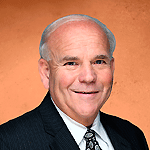January 2015
Marysol McGee: Welcome to the Federal Reserve's Economic Development podcast series. I'm Marysol McGee, community development analyst at the Federal Reserve Board of Governors.
At face value, a community's high school graduation rate may seem to be outside the scope of local economic development strategy. However, research shows this issue has been bearing on labor force participation rates and the economic vitality of communities. Indeed, both the rate of participation and quality of the local labor force are increasingly important in a firm’s decisions to remain or locate in a particular community.

Mike Beatty

Mike Wiggins
We're speaking today to Mike Beatty, president and CEO of Great Promise Partnership, and Mike Wiggins, the recently retired former executive vice president of human resources at Southwire Company. Welcome, gentlemen.
Mike Beatty, can you tell us about the Great Promise Partnership that grew out of the 12 for Life program? Specifically, what jump-started the initiative, and what are the key elements that contribute to its success?
Mike Beatty: We saw a clear need for a well-trained workforce and for a ladder to help our Great Promise youth, our at-risk youth. And we were working with communities, I had a chance to visit Southwire—the key element was a company's commitment to a community. Southwire had put together a process where they were working with these at-risk youth—they were going to school part of the day—they partnered with the school system in the community. And as I looked at what they were doing and saw the fact that it was really win-win, not only do you save the kids from dropping out of school, but you also have a process that’s very profitable for a company. And I really believe for this to be sustainable long term, it's got to be win-win for the community. And, of course, the other element was the need for a trained, motivated workforce.
The 12 for Life process is proven to help you graduate, go to college, join the military, or work full-time. And what we looked at was how we could replicate that, how we could scale that.
McGee: We know that workforce development is most successful when it's highly collaborative across sectors. Mike, who are the key partners involved in this program, and what are the recommendations for how to create strong community alliances like this one?
Beatty: What we saw was really four cornerstones that you've got to have to make this work. You’ve got to have the local political leadership. You have to have that bottom-up, locally driven approach through the local political leaders—the city hall and the county government. Also, you've got to have the school system that's flexible. One of the things that's so important is you have got to have that ability for the young person to leave school to get credit for working. Also, you've got to have the business community. And it's got to be win-win.
What we saw with both public and private enterprise and improvement on the bottom line is as you work with these highly productive youth on a short-shift concept where sometimes they're 25 to 30 percent more productive than adults. And you also have to have the faith-based community, the Boys and Girls Clubs, you've got to pull those four cornerstones together. We also put together a designation called "marquee community" that if you pulled all that together, if you helped a certain number of youth succeed, then you have a state-wide designation. And not only will they get recognition, but there’ll also be incentives from different state agencies and federal agencies for that community stepping up.
McGee: Mike Wiggins, your company represents one of the largest employers in your community. Why was the creation of 12 for Life important to your company?
Mike Wiggins: Let me begin with our commitment to education. Our first serious move in that direction was the proclamation that we would not hire any person for any job at Southwire Company who did not have either a high school education or a GED. In the rural communities in which we operate across the country, that really shook the foundation. But we said, anybody who works for us today is grandfathered, nobody's going to lose their job, and our intent is to make things better on a go-forward basis.
When we made that decision that any person that we hired had to have either a high school education or a GED to even fill out an application, little did we know at the time that was an incredibly major decision. It was OK when the economy was going great and we were growing, and we experienced business conditions like that for a number of years, but that doesn't last forever. In 2005 other businesses were coming into town—a great thing, the town, the community, the county was growing. But we began to be worried about getting an appropriate, adequate applicant pool from which to hire people. We had to look back at all that we had done, and we even had discussions of dropping that requirement for a high school education or a GED, but we said we believe that it has been successful, we believe that it has been instrumental in keeping some kids in school, and it’s the right thing to do.
Along the way we had created an initiative in our county called Carroll Tomorrow that was about a visionary look at our county and our population. And so that became a rallying cry for the entire area. And we were instrumental in funding that and being a driver in that whole process.
So we had a problem with making sure that we had an adequate applicant pool, and we had to take another look in order to assure that we could continue to grow in our home community. We got all the political leaders together and said, "We've got work to do. We're not happy with the dropout rate." So we held meetings with our family shareholders, and meeting with our board of directors, and meeting with the CEO to zero in on exactly what we wanted to do. Getting the school superintendent and the principals was an easy task because they had a problem and they didn't have the resources to manage that problem and to properly address that problem. So getting them on board was an easy thing.
So from March of 2006 until January of 2007, we bought a building, revamped and refitted the building to accommodate wire-making or wire-handling equipment. Then we started looking around for jobs that could be done in that facility and what equipment would be required.
But to reemphasize one more thing: what were the opportunities in our community? If we were going to grow there, if Southwire—being one of the largest employers in the county—if we were going to grow in our home community, an adequate, trained, and educated workforce was absolutely critical to our future. This became a major piece of strategy for the company and decision making on what we must do in order to grow.
McGee: You mentioned data. What are the evaluation metrics you are using to track the program's success, and can you share how the program has performed against those metrics since its inception?
Wiggins: I would approach that from two directions. One, from the education perspective, and then from the business perspective. From the education perspective, the measures that we track, number one is the graduation rate. Also, we now have 40 percent of our graduates who go on to postsecondary education.
More importantly, and I think the greatest measure of our success is the dropout rate for economically disadvantaged kids. It was 45 percent. Today that graduation rate is 79 percent. We've also hired quite a number of those graduates and they are productive employees at Southwire today, so that is another critical piece of what we’ve been able to accomplish.
On the business side, in addition to creating that applicant pool and having a trained, skilled workforce in the jobs that we utilize, we've incorporated much of our learnings into our total hiring process. For example, preemployment testing and evaluation—today it's an evaluation of the soft skills.
McGee: For communities considering replication of similar programs, what are some of the major challenges and opportunities in developing and implementing such an approach?
Beatty: From our standpoint it's really key to get the leadership together. We actually worked out a resolution for each cornerstone and make sure everybody understands what their role is.
Wiggins: The number one challenge for replication and moving it forward is convincing businesses.
We've had an almost continuing stream of visitors come to 12 for Life. They come in that facility and they see those kids work, and they see the activity, they hear the activity, they look at their charts on the wall, they go into the classrooms. The second most difficult thing, I think, is to have communities fully understand and appreciate the magnitude of this partnership that we've created between business and education.
And the schools have got costs. We've got full-time teachers and full-time county employees committed to 12 for Life. We've got very carefully selected teachers. That's just a significant commitment that they had to find ways to fund and be able to sustain.
The schools were able to secure a grant to offer higher levels of STEM [science, technology, engineering, and mathematics] education at 12 for Life. That's the reason Southwire constructed the school inside 12 for Life. What that’s enabled us to do is we run three four-hour shifts. So some kids go to school and then they come to work; some kids go to work and then they go to school. The kids that are most at risk or the most academically disadvantaged, they may have to go school all day and then work the evening shift.
McGee: Thank you for speaking with us today. This concludes our podcast with Mike Beatty and Mike Wiggins.
The Federal Reserve's ninth biennial Community Development Research Conference will be held in Washington, D.C., in April 2015. The conference will address a diverse set of issues shaping community development policy and practice. More information on the agenda and the registration details are available on the St. Louis Fed's website![]() .
.
For more podcasts on this topic and others, please visit the Atlanta Fed's website at frbatlanta.org. If you have any comments or questions, please e-mail podcast@frbatlanta.org. Thanks for listening.
Related Links on Other Sites

